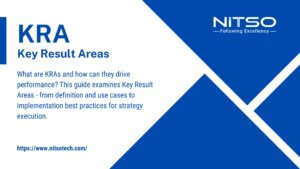Goals are vitally important for leaders. For an organization to thrive, leaders must set clear objectives and goals as a leader that align with the overarching vision and mission. Leaders cannot simply assume goals will be achieved – they must actively work towards them.
When leaders set objectives yet attainable goals, it motivates teams to bring their best efforts. Leaders who set vague or easy goals fail to provide this sense of purpose. In today’s fast-changing world, leaders must regularly revisit and adapt goals while keeping the end vision in sight. By embracing goal-setting as an integral part of leadership, organizations and teams can reach higher levels of performance.
Table of Contents
Why leaders specifically need clear objectives and goals
Leaders need clear objectives and goals as a leader for several crucial reasons:
- Goals as a leader provide direction and focus: They define what needs to be accomplished both short-term and long-term. This gives teams clarity on priorities.
- Goals as a leader enable tracking and measuring progress: Metrics and milestones allow leaders to monitor performance against targets.
- Boost motivation and engagement: Ambitious yet attainable goals inspire teams to push themselves.
- Facilitate problem-solving: When obstacles arise, goals help teams stay focused on solutions.
- Goals as a leader promote accountability: They ensure leaders and teams take ownership of outcomes and deliverables.
- Help sustain momentum: Short-term goals drive momentum towards the long-term vision.
In summary, embracing goal-setting is crucial to leadership success. Leadership goals provide focus, accountability, motivation and a way to measure progress.
Top 15 objectives and goals as a leader for business development
1. Have a Clear Vision
As a leader, it’s crucial to have a well-defined vision for where you want to take the business long-term. This could be expansion into new markets, introducing disruptive technology, or becoming an industry leader. For example, the CEO may have a vision to grow internationally and expand the company’s footprint globally within the next 5 years. This provides a guiding light for setting strategic goals.
2. Set Priorities
With a vision in place, leaders must set priorities and determine the most important business development goals to pursue at any given time. This means evaluating factors like current capabilities, market conditions, and competitive landscape. For instance, given limited resources, launching and scaling a new product line may have to take priority over opening new office locations this year.
3. Communicate Goals
For alignment across the organization, leaders must clearly communicate business development goals once they are set. The CMO may share the goal of increasing market share in the company’s core customer segment by 10% this fiscal year. When everyone understands the goals, they can work collaboratively to achieve them.
4. Develop Strategic Plans
With goals set, extensive strategic planning is required to map out how the goals will be reached. Leaders must define tactical plans, set milestones, allocate resources, and identify critical steps to execute on each business development goal. The strategic plan for the goal of expanding manufacturing capabilities may detail the timeline, budget requirements, facility upgrades, hiring plan, supply chain coordination, and moreover a 2-year timeline.
5. Set Performance Goals
Leaders must break down broader business development goals into specific performance goals and metrics for themselves and their teams. For example, the VP of Sales may set a performance goal of acquiring 100 new mid-market customers per month in order to achieve the broader goal of increasing market share. Defining these performance measures creates clarity and accountability.
6. Foster Teamwork
Many business development goals require cross-team collaboration to succeed. Leaders should promote teamwork by having teams across departments, such as marketing, product, sales, and customer service, work together to brainstorm and execute plans to achieve the goals. The cooperative effort to create an improved customer referral program utilizes diverse expertise across many functions.
7. Provide Resources and Support
Leaders must assess the budget, staff, tools, and other resources required to realistically achieve a business development goal and fully support their teams. For instance, hiring additional technical staff and increasing R&D budget allocation may be imperative to facilitate the efficient development of a new product line. Teams are set up for success when given adequate resources.
Article you might be intrested in: Exploring Turnaround Strategies and Their Importance
8. Measure Progress
Ongoing measurement and analysis of progress made towards business development goals is imperative. This may involve assessing lead generation reports, sales pipeline trends, customer acquisition rates, new market penetration, web traffic, brand awareness, and other metrics. Leaders can correct when they have transparency into what is working well versus not.
9. Motivate and Inspire
Not only do leaders have to set the direction when it comes to ambitious business development goals, but they must also motivate and inspire their teams around those goals. Recognizing achievements, providing encouragement during setbacks, and celebrating wins big and small are critical. For example, the CEO may take the team that successfully executed a major product launch out for dinner to celebrate. This builds morale and engagement. To know more you can check out our blog on Celebrate Team Successes the Right Way: Learn How to Motivate Your Staff Through Recognition.
10. Be Adaptable
In dynamic and evolving business environments, leaders must be ready to adapt to goals when conditions change or initial projections are off-base. Business development goals set even a year ago may need major adjustments based on new market entrants, emerging technologies, economic shifts, and other external factors. Being nimble and responsive demonstrates strategic leadership.
11. Learn from Setbacks
When business development goals are not met as expected, leaders must openly examine why they fell short for the purposes of learning and continuous improvement. Without this analysis, similar missteps are likely to repeat. If a customer acquisition goal was missed, leaders should work with their team to honestly assess what did not work as planned and how their process can improve next time.
12. Maintain Accountability
Consistent tracking and review of business development goal progress is imperative for accountability. Leaders must hold regular check-ins with their direct reports and team members to assess the status of assigned goals and targets. For example, the COO may have monthly reviews with each department head on their progress and roadblocks. This ensures business development goals remain a priority.
13. Reward Success
Recognizing and rewarding teams or individuals who achieve their business development goals is a critical part of the process. Rewards and recognition reinforce what behaviours and outcomes are valued. The CEO may take the sales team that generated 20% revenue growth this year on an all-expenses paid resort trip to celebrate their collective achievement.
14. Align Organization-wide
Driving coordinated business development across the organization requires alignment between departments. When setting goals, leaders should ensure various departments and teams are working towards the same primary objectives in a cohesive strategy. For instance, operations and marketing should enhance and complement each other, not conflict.
15. Focus on Growth
Business development goals should ultimately be structured around growth – growth of market share, customers, capabilities, and employee skills. Leaders must challenge teams with stretch goals for business development that seem ambitious but are attainable with dedication. This focus propels innovation and competitiveness.
Article you might be intrested in: What are the Top 15 Monetary Benefits For Employees
Parting Words
Setting clear goals as a leader is a hallmark of effective leadership and is crucial for guiding business development. When leaders actively set aligned objectives, track progress, motivate teams, and adapt as needed, it drives successful outcomes. Goals as a leader provide focus amid uncertainty and enable organizations to channel efforts toward a common purpose.
By following the best practices outlined, including establishing priorities and strategic plans, fostering teamwork, allocating resources, maintaining accountability, and focusing on growth, leaders can maximize their business development results. Leaders must remember that goal-setting is not a one-time event, but rather an ongoing exercise as market dynamics shift.
Regularly revisiting and realigning leadership goals based on new opportunities ensures continued relevance. By embracing goals as a core leadership capability and keeping the end vision in sight, organizations can fulfil their purpose and reach their full potential.
FAQs related to goals as a leader
What is a smart goal for leadership?
A SMART goal for leadership is Specific, Measurable, Achievable, Relevant, and Time-bound. An example is “Improve employee satisfaction scores by 5% over the next 6 months by implementing bi-weekly check-ins”.
What is the main goal of a team leader?
The main goal of a team leader is to provide direction and motivation to their team in order to achieve collective objectives. They work to align, inspire and develop their team members.
What are the 3 types of goals?
The 3 main types of goals are:
Long-term goals – 1 year or longer
Short-term goals – 3 months to 1 year
Immediate goals – 1 week to 3 months
What are 5 SMART goals examples?
Complete 10 new client profiles each week (Specific, Measurable, Time-bound)
Increase revenue by 20% in the next fiscal year (Specific, Measurable, Achievable, Relevant, Time-bound)
Launch a redesigned company website in Q3 (Specific, Time-bound)
Respond to all customer inquiries within 24 hours (Specific, Measurable, Achievable)
Take a coding class to gain skills for a new role (Specific, Time-bound, Relevant)
What makes a good leader?
Some qualities that make a good leader include excellent communication skills, empathy, confidence, integrity, and the ability to inspire others and command respect. Good leaders think strategically, motivate teams, and help others develop.
How do you set goals as a leader?
Leaders should set specific, measurable goals aligned to the company vision. They should outline detailed plans to achieve each goal and get team input. Leaders must track progress and key metrics regularly, be adaptable, and maintain accountability.
How do leaders achieve goals?
Leaders achieve goals by clearly communicating them, securing team buy-in, providing necessary resources and support, fostering collaboration and ownership, measuring progress, and offering encouragement/incentives.
What are professional goals?
Professional goals are career objectives focused on skills development, level of contribution, and career advancement. Examples may be achieving a promotion, leading a key project, improving skills through training, taking on more responsibility, etc.
Which type of goal is best?
S.M.A.R.T. goals are considered the best type of goal. They are Specific, Measurable, Achievable, Relevant and Time-bound. S.M.A.R.T. goals provide clarity and enable progress tracking.
What are 3 good goals in life?
Three good life goals could be:
Maintain work-life balance
Build meaningful relationships
Live a healthy, active lifestyle
What are the 7 steps of goal setting?
The 7 key steps in goal setting are:
Identify the goal
Set a timeframe
List required resources
Identify milestones and metrics
Anticipate obstacles
Create a structured plan
Monitor and adjust as needed
What can a leader achieve?
Effective leaders can achieve many things such as rallying people around a vision, setting strategic direction, boosting team performance, executing new initiatives, driving change, improving morale, and creating an empowering culture.
How do leaders succeed?
Leaders succeed by having a clear vision, setting measurable goals, leading by example, communicating effectively, building trusted relationships, empowering others, promoting collaboration, and continuously developing their skills.
How do goals lead to success?
Goals lead to success by providing focus and direction, enabling measurement of progress, boosting motivation and accountability, aligning teams to a shared purpose, facilitating problem-solving, and allowing for recognition of achievements.








0 Comments